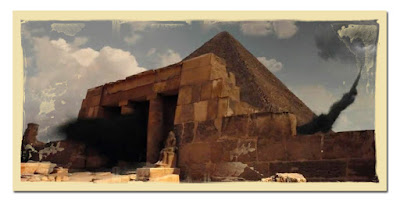Excavator Hourig Sourouzian and her team of archaeologists found some more statues of Sekhmet at Kom el-Hettan (click here for the press release).
Kom el-Hettan was built by Amenhotep III in the 14th century BC as his so-called "house of millions of years", a term often (mis-)translated as "mortuary temple" or "funerary temple". The temple precinct was surrounded by a 700 metres long and 550 metres wide wall that was eight and a half metres strong - it enclosed an area even bigger than the temple complex of Amun in Karnak (530 x 515 x 530 x 610 m, the temple precinct there is not rectangular).
 |
|
The Colossi of Memnon at the entrance gate to the temple of Amenhotep III in Western Thebes |
The temple of Amenhotep III is situated on the West bank of the Nile opposite Luxor and is most famous and most recognizable for his two colossal statues of the seated king which flank the first of the four entrance gates to the temple. Each of them is 23 metres high. Countless other huge statues of the king were discovered in the temple area, two of which were found in fragments prior to 2014, but resurrected afterwards next to the temple of Merneptah where they can be visited today.
 |
|
The newly erected statues of Amenhotep III next to the temple of Merneptah |
The Sekhmet statues found this month were not the first discovered there either. The discovery of such artifacts in Kom el-Hettan often made the news - at least four times in the last three years (january and march 2013, february 2015 and again march 2016). In february 2015 the field director Hourig Sourouzian said that she and her team found 64 statues of the goddess Sekhmet until then. But many more exist: up to 600 statues are preserved today, but most of them are scattered around the world, e.g. fragments of 20 Sekhmet statues are kept at the British Museum London. It is said that there may have been 730 statues of Sekhmet in total at Kom el-Hettan, one seated and one standing for each day of the year, but this hypothesis hasn't been confirmed yet. It is also unclear why Amenhotep III placed so many statues of the goddess in his temple.
Sekhmet was very popular during the New Kingdom and later. She was venerated with her husband Ptah in his temple in Memphis, but this connections wasn't established prior to the 18th Dynasty. Unfortunately, earlier places of worship are hard to grasp. It is possible that Sekhmets cult originated in the Delta, near the town of Letopolis in the second nome of Lower Egypt, but archaeological evidence is still missing.
 |
| Bust of Sekhmet, ca. 1390-1352 B.C. found in the Temple of Mut in Karnak (Inv.-Nr. 1991.311, CC-BY 3.0, Original Photo: Brooklyn Museum) |
Sekhmet was the daughter of the sun god Re since at least the New Kingdom. As such she is often referred to as the "Eye of Re" and wears a sun disk on her head as a symbol for her connection to this god and the burning nature of the sun. As his daughter she did his bidding in the myth of the destruction of mankind in which humanity is almost wiped out for their sinful behavior and rebellion against the sun god.
Sources:
H. Gauthier, Les statues Thébaines de la déesse Sakhmet, in: ASAE 19 (1919) pp. 177-203
G. Haeny, Untersuchungen im Totentempel Amenophis' III., BeiträgeBf 11 (Wiesbaden 1981).
M. Lichtheim, Ancient Egyptian Literature II. The New Kingdom (Berkeley/Los Angeles/London 2006) pp. 197-199.
H. Sternberg, Sachmet, in: LÄ V, Sp. 323-333.




